 |
|

|
 |
TABLE of CONTENTS
|
Governor unveils 'Budget for One Minnesota' |
By Nick Carpenter, Government Affairs
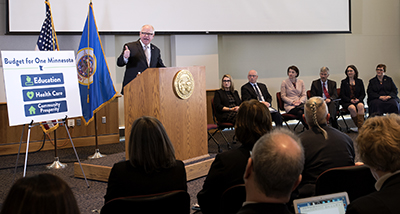
Gov. Tim Walz presented his budget proposal during a news conference Feb. 19 in St. Paul. With the governor were Lt. Gov. Peggy Flanagan, Commissioner Myron Frans, Minnesota Management and Budget; Commissioner Cynthia Bauerly, Department of Revenue; Commissioner Tony Lourey, Department of Human Services; Commissioner Mary Cathryn Ricker, Department of Education, and MnDOT Commissioner Margaret Anderson Kelliher. Photo by Rich Kemp |
A statewide gas tax increase coupled with higher vehicle registration and sales taxes highlight a comprehensive funding plan aimed at addressing Minnesota’s aging transportation infrastructure.
Gov. Tim Walz officially unveiled his Budget for One Minnesota Feb. 19. The $49.5 billion proposal for the 2020-2021 biennium includes broad investments in education, health care and community prosperity, which covers transportation and infrastructure improvements.
Major transportation-related elements of the governor’s budget proposal include:
- Initiating a 20-cent gas tax increase, which will begin as a 5-cent tax increase and be phased to 20 cents by adding an additional 5 cents every six months for two years.
- Indexing the gas tax to inflation—approximately 1.3 cents per year—beginning in Fiscal Year 2023.
- Eliminating the statutory authority that dedicates all general fund revenues to the Highway User Tax Distribution Fund—$450 million in fiscal years 2020 and 2021. Seven cents of the gas tax increase will replace the general fund reduction.
- Increasing the registration tax beginning Jan. 1, 2020. This includes increasing the tax rate from 1.25 percent to 1.5 percent and the base tax fee from $10 to $45.
- Increasing the motor vehicle sales tax from 6.5 percent to 6.875 percent beginning Dec. 1, 2019.
- Authorizing $2 billion in trunk highway bonds over eight years starting in 2022.
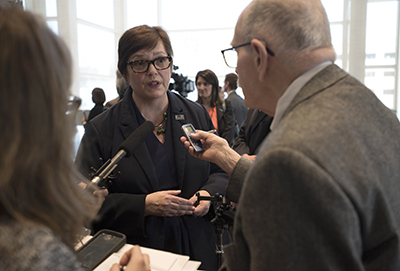
Commissioner Margaret Anderson Kelliher spoke to members of the media Feb. 19 after Gov. Walz announced his proposed budget. Photo by Rich Kemp |
Gov. Walz also is proposing an increase to the Working Family Credit of $100 for each single or head-of-household recipient and $200 for each married filing joint recipient. This aims to help lower- and middle-income Minnesotans pay for transportation investments.
The funding increase is expected to cover the general fund reductions and all the existing bond debt, as well as fill the 10-year funding gap of $6 billion identified in MnSHIP, the department’s 20-year investment plan.
The proposal also includes numerous change items aimed at supporting the maintenance of existing MnDOT services to stabilize funding for transportation in critical areas. This includes:
- Maintaining existing service levels to attract and retain a diverse workforce
- Making investments to offset reduced buying power due to inflation, including commodity purchases for salt, sand, fleet replacement and pavement preservation
- Maintaining critical investments in key customer-facing applications that are most at risk of failure and pose the highest cyber security risks
- Funding for a backlog of investments in aeronautics operations and airport improvements across Minnesota
For more information about the governor’s budget proposal, visit www.dot.state.mn.us/transportationfunding/.
Governor proposes $1.3 billion bonding bill
One week after releasing his proposed budget, Gov. Walz unveiled a bonding proposal that would invest nearly $1.3 billion in community infrastructure projects across the state.
The proposal recommends:
- $100 million for the local road improvement program
- $100 million for the local bridge replacement program
- $52 million for a rail grade crossing separation in Moorhead, which has one of the highest levels of rail and vehicle traffic in the state
- $10 million for the Safe Routes to Schools grant program
For a more detailed look at all proposed investments, visit Governor's 2019 Capital Budget Recommendations. |
 |
|

|
 |
TABLE of CONTENTS
 |
Jake Loesch named as senior director of Strategic Communications |

Jake Loesch is the director of Strategic Communications. Photo by Rich Kemp |
Jake Loesch has joined MnDOT as the new senior director of Strategic Communications. In this new role, Loesch will work closely with Kevin Gutknecht, Communications director, and the Communications team to shape the agency’s communication strategies, ensuring we are telling MnDOT’s story and effectively connecting with Minnesotans.
Most recently, Loesch worked in public relations and government relations at Goff Public, where he represented nonprofits, businesses and local governments, and educational institutions. His professional experience also includes time at the Minnesota Legislature, leading communications for the historic Minnesotans United for All Families campaign, and managing a first-of-its-kind public education and advocacy effort across 14 states in the American South.
Loesch was a 2017-18 policy fellow at the Humphrey School of Public Affairs and currently serves on the Board of Directors of the Citizens League and the Campaign Council of Twin Cities Habitat for Humanity. He is a 2009 graduate of the University of Minnesota-Duluth.
“Jake brings nearly a decade of experience in strategic communications to MnDOT,” said Commissioner Margaret Anderson Kelliher. “I’m confident that Jake’s insights will be invaluable as MnDOT builds for the future.” |
 |
|

|
 |
TABLE of CONTENTS
 |
African-American Employee Resource Group presents workshop on professional development |
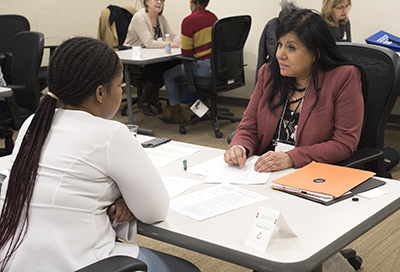
Lena Garcia (right), Human Resources, assists TyShana Byrd-Guilmant, Central Office training coordinator, during one of the breakout sessions of the Professional Development Workshop. Photo by Rich Kemp |
The African-American Employee Resource Group hosted a Professional Development Workshop Feb. 11 in the Central Office TEC Center. The workshop, titled “I Am Next: My Career, My Progress,” featured an interactive format and useful tools designed to improve participants’ skills while helping prepare them for the next steps in their career at MnDOT.
“In addition to community outreach, AAERG focus areas include recruitment, retention and professional development,” said John Tompkins, AAERG co-chair. “Preparing our members for career advancement not only complements the Strategic Operating Plan but also represents our commitment to make MnDOT as good as its promise to be a diverse and inclusive organization.”
The day’s events covered a wide range of developmental topics. Participants and volunteers received practical tips on networking and articulating their personal brand from Lynn Pingol, director of MnDOT's DBE Learning Hub and Small Business Resource Center. Several senior leaders shared words of wisdom on their respective journeys while also shedding light on the interpersonal skills and technical knowledge needed to become a leader at MnDOT. Gloria Jeff, Re-thinking I-94 Project director, presented on how to have the crucial conversations associated with professional growth.
Christine Fisher and Glenn Payton from Human Resources provided information to the participants about the career paths within MnDOT. AAERG Champion Richard Davis and Commissioner Margaret Anderson Kelliher also provided comments to the group. Amanda Klawiter and Shawn Meade, Training, provided an overview about Strength Finders as part of a discussion about the importance of self-assessments.
“This event was a team effort and very well received due to the efforts of all those involved,” said AAERG Co-Chair Terrina White. “We’re grateful for the support of senior leadership not to mention the time given by allies, members and volunteers, particularly Jon Solberg, who organized breakout sessions for resume reviews and mock interviews.”
The workshop included participants from districts and Central Office and several volunteers. Representatives from the Office of Equity and Diversity, Human Resources, the Office of Public Engagement & Constituent Services, Printing and Electronic Media Services, Facilities and Communications were all involved in the planning and execution of this innovation workshop.
The AAERG was formally organized in 2013 to advance MnDOT’s diversity and inclusion strategy. AAERG is dedicated to the interests of employees who self-identify as Black, African-American, West Indian, of any African descent and allies/partners who have a shared interest.
For more information about the AAERG and other Employee Resource Groups at MnDOT, visit the ERG page on iHub.
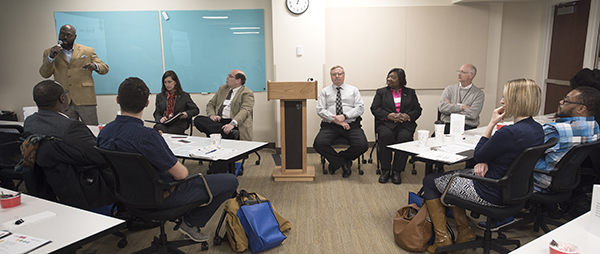
During the Professional Development Workshop, Garland Jackson, MNIT, moderated a panel discussion on the path to leadership. The panel included (from left) Nancy Daubenberger, assistant commissioner, Engineering Services; Josh Root, Chief Counsel Office; Mike Barnes, I-94 corridor director; Gloria Jeff, Re-thinking I-94 project director, and Mitch Rasmussen, assistant commissioner for the State Aid Division. Photo by Rich Kemp |
|
 |
|

|
 |
TABLE of CONTENTS
 |
Library migrates to new services platform |
By Marilee Tuite, MnDOT Library
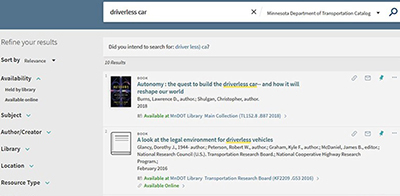
The Library has a new services platform, including the online catalog. |
After months of preparation, MnDOT Library has successfully migrated to a new library services platform, including the online catalog available via www.mndot.gov/library. Other state agencies and Minnesota State Colleges and Universities libraries have completed the same migration to this platform, which is also used by the University of Minnesota libraries.
What does this mean for employees?
- The library homepage is still a starting place for searches. Employees will notice a different interface in the results screen.
- The new catalog expands searching beyond MnDOT Library’s physical collection. For example, there is the option to include journal articles from databases like Academic Search Premier in search results. The search can also be set to Library Catalog only, as in the image posted with this article.
- Interlibrary loan service will continue as before. Let the library staff know if you need to borrow a book or request a full-text article that isn’t owned by MnDOT.
Contact the library with any questions about the new catalog: 651-366-3791 or Ask a Librarian request form. |
 |
|

|
 |
TABLE of CONTENTS
 |
Sue Mulvihill receives Ray L. Lappegaard award |
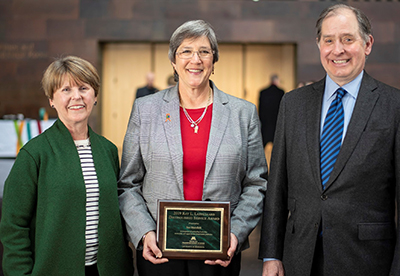
Laurie McGinnis, CTS director (left) and former MnDOT commissioner Charlie Zelle presented Sue Mulvihill with the Ray L. Lappegaard Distinguished Service Award Feb. 20. Photo by Michael McCarthy, Center for Transportation Studies |
Sue Mulvihill, deputy commissioner and chief engineer, received the Ray L. Lappegaard Distinguished Service Award Feb. 20 during a ceremony at the University of Minnesota.
The award is presented to a transportation professional who displays outstanding leadership, mentorship and support to the profession. The award is named in honor of Ray L. Lappegaard, chair of the Center for Transportation Studies Executive Committee from its creation in 1989 until his death in April 1993. Lappegaard, who was Commissioner of Highways from 1971-74, held numerous high-level positions in state government and the private sector, and was a mentor to many in the transportation field.
In her 35 years with MnDOT, Mulvihill has held several leadership positions, including program delivery director for the Metro District and division director for operations. She has been involved in many statewide and department initiatives throughout her career. |
 |
|

|
 |
TABLE of CONTENTS
 |
Jon Huseby receives distinguished public leadership award |
By Sandra Schlagel, District 8 public affairs coordinator
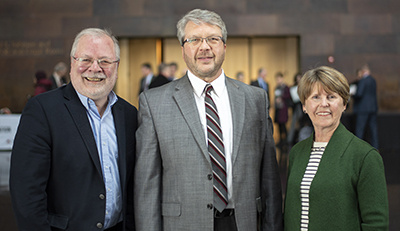
Jon Huseby (center), District 8 engineer, is pictured at the 2019 Annual Meeting and Awards Luncheon with Lee Munnich, Senior Fellow, State and Local Policy Program, Humphrey School of Public Affairs, and Laurie McGinnis, CTS Director. Photo by Michael McCarthy, Center for Transportation Studies |
District 8 Engineer Jon Huseby, is the 2019 recipient of the Center for Transportation Studies – Distinguished Public Leadership Award. The award was established in 1998 to recognize public leaders who have influenced innovative transportation policy directions that benefit society through their vision, leadership and knowledge.
Huseby received the award Feb. 20 during the 2019 Annual Meeting and Awards Luncheon for the Center for Transportation Studies in Minneapolis. As the leader for one of MnDOT’s eight districts, Huseby is involved in many statewide transportation initiatives at MnDOT. He is also a member of the Transportation Policy and Economic Competitiveness Advisory Board at the Humphrey School of Public Affairs and the Minnesota Freight Advisory Committee Executive Board.
“Transportation connects to all parts of our society. It affects the economy and our quality of life, from moving commuters, to moving freight in the Metro and Greater Minnesota. We’re all part of a transportation network,” said Huseby. “That’s what drives me to be involved so that we as an organization get a good understanding of how decisions we make influence businesses and highway users in southwest Minnesota and across the state.”
In 2013, Huseby initiated the Manufacturers’ Perspectives on Minnesota’s Transportation System in District 8 as a business outreach, bringing a manufacturer’s perspective to the table. That program has now expanded to four other districts and played a role in redefining the Minnesota Freight Advisory Commission.
Huseby said he was surprised and honored to receive the award.
“Receiving an award for something that I have a passion for doing was never expected,” said Huseby. “I feel very fortunate to be working with great people at MnDOT, and with our many partners.”
Past award recipients have included state and federal legislators, local government officials and others concerned with transportation issues for Minnesotans. Learn more at http://www.cts.umn.edu/about/awards/leadership. |
 |
|

|
 |
TABLE of CONTENTS
 |
Winter is no match for this 51-year-old snow blower |
By Sue Roe
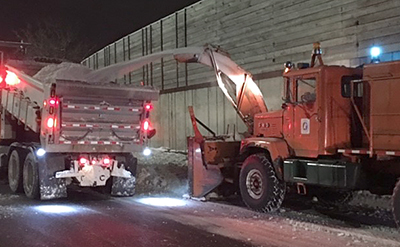
Herman the snow blower clears snow from the side of a highway in the Twin Cities Metro area. Photo courtesy of the Metro District |
As the snow keeps piling up in this record-breaking February, an antiquated piece of rusty snow blowing equipment takes center stage at the Spring Lake Park truck station. This 1968 truck mounted Sno Go, affectionately called Herman Munster, can be seen churning up and spitting out snow during clean-up operations after a winter storm.
“Herman blows snow really well,” said Joe Groshens, truck station supervisor. “He doesn’t have any computers. He’s not been updated. Mechanics like to work on him because he’s all mechanical.”
Herman is among the oldest pieces of snow and ice equipment at MnDOT. The odometer reads 47,429 miles. A meter, which tracks how many hours the engine runs, reads 1,177 hours.
The dashboard and interior look like something out of, well, the 60s. Groshens described it as “old school.”
An extra “pony” motor runs the blower. Operating the truck and blower is a two-person job. One person operates the chute while another operates the truck.
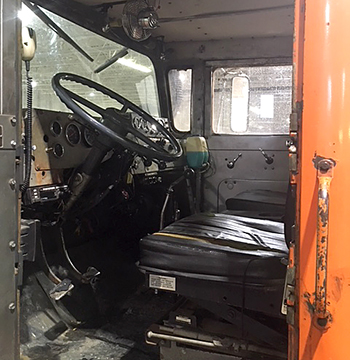
The cab for Herman the snowblower is a lttle different than the newer versions, but the snowblower has continued to help clear the roads around the Twin City Metro area. Photo by Joe Groshens |
Originally, the auger had wings that moved left or right to cut into snowbanks, but Groshens said they were welded shut and now the wings only go in a straight line.
But Herman works so well that once, when he was out “eating snow,” he ate a piece of concrete. Groshens said the piece of concrete went through the auger and flew out of the chute.
“Normally, the concrete would jam in the auger and break a sheer bolt, which is designed to break and release the power head from the auger to prevent damaging the power head or auger,” Groshens said. “Herman eats car parts. He’s made of steel and that’s a testament to why he’s still running. He’s built well.”
So well, that in 2015, there was one snow event when Herman was the only snow blower working in the Twin Cities Metro area. Goshens said Herman was farmed out to other truck stations while mechanics scrambled to repair the broken down equipment.
This week, Herman traveled to Owatonna with other Metro snow blowers to help get Interstate 35 reopened.
|
In this video, Herman the snowblower helps clear Interstate 35 near Ellendale during a recent snow event. Video courtesay of District 6 |
Herman has been at the Spring Lake Park Truck Station since 2012. Before that, he was at the Oakdale Truck Station. MnDOT’s digital records only go back to 1999, so it’s unknown what other locations he’s served.
Herman has been “resurrected” many times. Groshens said one time, the mechanics worked on him for three months to get him back to working order.
“Everybody knows who Herman is and where he’s at,” Groshens said. “I’m not sure how long they plan to leave Herman in our shop but we plan to keep using him until the day they haul him out of here.”
That day is coming soon. Herman is scheduled to go on the auction block, likely this summer.
|
 |
|
| |
|



